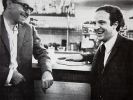Eye For Film >> Movies >> Two In The Wave (2009) Film Review
For Godard fans, and probably Truffaut fans as well, a documentary about their friendship, generously illustrated with clips from their movies, sounds like manna from heaven. Godard famously said, “All you need for a movie is a gun and a girl.” This documentary doesn’t have the needed girl in it. Perhaps it should have, if only to show the human side of these men. Neither does it have much in the way of a gun. And a gun was definitely needed – preferably to shoot the director before he made this.
Not that the history of these two seminal filmmakers, their initial close friendship, and their later parting over fierce artistic differences shouldn’t be told. Perhaps it should. To examine those differences or even to analyse the individual greatness of Godard and Truffaut. That the present offering would look out of place even as a DVD extra is not only a condemnation of its artistic integrity, but singularly odd - some will take it almost as a besmirchment of the great traditions that Godard and Truffaut spearheaded. Imagine ‘Burger King does Gordon Ramsay,’ complete with a cappuccino decoration of white beans and grated truffles, filched from a restaurant near you and diluted with soya flour and monosodium glutamate.

Before pointing out a couple of good things about the film, I feel a need to explain at greater length why it would have been best if it hadn’t seen the light of day, much less a festival selection (which tacitly suggests it has merit, even if the object is to ‘sell tickets’).
Of the many expositions of the two key movies widely identified as kick-starting the French New Wave, Breathless (Godard) and The 400 Blows (Truffaut), this documentary seems aimed at leaving the viewer with even less information than they came in with. An uninspired commentary gives little mention of the directors' innovative styles and techniques, with clips seemingly used at random (and often poorly at that). At best it offers the sort of history you could get in five minutes from Wikipedia. We hear much about their love of movies but with only the most superficial of clues as to the intellectual passions and insights that might distinguish them from the most moribund of cinema-goers. We have, in short, no analysis.
Emmanuel Laurent’s Two In The Wave had its UK premiere at the Edinburgh International Film Festival and recalled a similarly mediocre film from the year before, For The Love Of Movies: The Story Of American Film Criticism. Both films try to work off the back of truly gifted people. Both fail by dint of lacklustre composition, poor presentation of relevant knowledge, and being totally unable to satisfy expectation.
Of the things I couldn’t help but enjoy though, were the scenes from the movies. I managed to identify most of them, and playing ‘spot the clip’ gave me something to do while tuning out commentary that narcissistically imagines it is doing me a great service - even with its room temperature IQ. But what of other viewers? For an introduction to the men and their work, shouldn’t the films have been identified? Or at least the relevant techniques highlighted by commentary?
As an example, the back of my mind recalls a tracking shot in a clip being shown that has a jump cut. Some moments after (not before or during) the jump-cut, but immediately before switching to another film clip, the commentator says how . . . ‘they were setting out to destroy the notion that you can’t jump-cut while tracking.’ The clip that then begins, immediately after this apparently sensible remark, is from À Bout De Soufflé: a film particularly famous for its use of jump-cuts. Let’s watch and see which sequence they use! Mmmm... not a tracking shot for a start... and the cuts in this particular piece of film (in a moving car) are of the traditional kind.
Fortunately a film about Godard would struggle to be all bad. Two In The Wave comes alive in the clips of interviews with Godard himself. Apart from seeing his movies, it is one of the best ways of getting insights into them. Additionally, Godard speaks as passionately in word and deed as he does at 24 frames per second. He can probably tell us more about filmmaking in five minutes than all the pompous drivel that is wasted by many of the writers filling books (or in this case films) on his works.
Another morsel of worth was the inclusion of student riot footage, which is better than average and helps to illustrate the rebellions against what was seen as Gaullist repression of the arts and artistic freedom of expression generally. These events of 1968 are almost part of cinema legend. While Two In The Wave could have gone much further and looked at the differing views of the importance attributed to Godard and film in history’s recollection of the unreast, by the time the film gets to this point one is grateful for any small mercies.
A bigger shortcoming is the lightweight manner in which Godard and Truffaut’s disagreement is handled, since their friendship is the film’s primary stated remit. The best one can gather is that Godard was somehow interested in using film for political ends, whereas Truffaut was concerned with film as fine art, or art for art’s sake. While this is correct as far as I understand it, it would have been a great opportunity to examine the arguments over which they found such passionate disagreement.
Sadly Two In The Wave is little more than a pretentious fanzine-style offering, couched in deceptively cultured tones.
Reviewed on: 24 Jun 2010


















